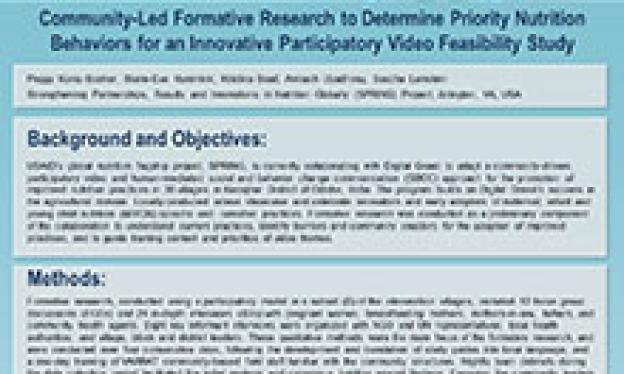Authors: Koniz-Booher P; Hammink M; Beall K; Upadhyay A; Lamstein, S
Background and objectives: USAID’s global nutrition flagship project, SPRING, is currently collaborating with Digital Green to adapt a community-driven, participatory video and human-mediated social and behavior change communication (SBCC) approach for the promotion of improved nutrition practices in 30 villages in Keonjhar District of Odisha, India. The program builds on Digital Green’s success in the agricultural domain. Locally-produced videos showcase and celebrate innovators and early adopters of maternal, infant and young child nutrition (MIYCN)-specific and -sensitive practices. Formative research was conducted as a preliminary component of the collaboration to understand current practices, identify barriers and community enablers for the adoption of improved practices, and to guide training content and priorities of video themes.
Methods: Formative research, conducted using a participatory model in a subset (6) of the intervention villages, included 12 focus group discussions (FGDs) and 24 in-depth interviews (IDIs) with pregnant women, breastfeeding mothers, mothers-in-law, fathers, and community health agents. Eight key informant interviews were organized with NGO and UN representatives; local health authorities; and village, block and district leaders. These qualitative methods were the main focus of the formative research, and were conducted over four consecutive days, following the development and translation of study guides into local language, and a one-day training of VARRAT community-based field staff familiar with the community structures. Nightly team debriefs during the data collection period facilitated the initial analysis and consensus building around findings. Engaging the community leaders and using participatory methods helped to ensure community buy-in.
Results: Breastfeeding is universal, but is commonly supplemented early during the first six months
- Timing, diversity, density, and frequency of complementary feeds are not well understood.
- Hand washing is seldom practiced before preparing meals or feeding infants, and soap is not used.
- Women are expected to do work throughout pregnancy, with little rest, and they often return to strenuous field work following the traditional 21-day confinement.
- Many high-quality foods and iron-folic acid are thought of as “harmful” to the baby and/or mother.
- Mothers-in-law and husbands both continue to play critical roles in the support network of mothers, with many acknowledging that the traditional structures and societal norms are changing.
- Mothers-in-law are major decision makers in the family structure, generally controlling the division of labor.
- Mothers-in-law decide the quantity, quantity, and frequency of food that pregnant and lactating women eat, as well as how food is allocated within the family.
These results were fundamental to the design of the SPRING/Digital Green Collaboration, informing the selection of priority nutrition behaviors for 10 nutrition videos; the design of a series of two-day nutrition sensitization trainings for key community agents; the overall strategy for the production and dissemination of nutrition videos, and the verification points for the behavioral adoptions tracking plan. The sensitization trainings included VARRAT video production and dissemination teams, the Anganwadi Workers (AWWs), and the Accredited Social Health Activists (ASHAs) working in the participating villages. These short, highly participatory trainings focused on MIYCN practices prioritized through the research, and provided a critical skill-based foundation, especially for the VARRAT staff whose work previously focused on the promotion of agricultural practices.
Conclusions: The participatory nature of both the formative research and training served to strengthen the collaboration among the various community stakeholders, and many AWWs and ASHAs subsequently engaged in the actual production of the nutrition videos. The methodology used in this research and the immediate application of findings was consistent with SPRING’s goal of testing an innovative, highly promising, scaleable, community-led approach for nutrition SBCC.
